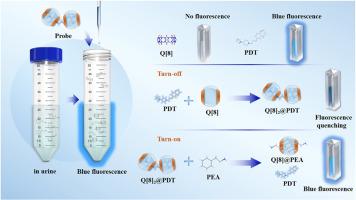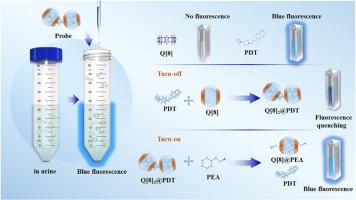A novel cucurbit[8]uril-based fluorescent probe for the detection of phenethylamine in urine
IF 6
2区 化学
Q1 CHEMISTRY, ANALYTICAL
引用次数: 0
Abstract
Background
Beta-phenylethylamine (PEA), is known to scientists as the “mood hormone”, posing a threat to human health. In this study, an “on-off-on” supramolecular fluorescent probe was developed for the detection of PEA. The probe, namely PDT@2Q[8], was assembled from cucurbit[8]uril (Q[8]) and a coumarin derivative (PDT) via a host-guest interaction in a 2:1 binding ratio.
Results
The solution fluorescence was turned on again when PEA was added to PDT@2Q[8] in aqueous solution. The intensity of the fluorescence of the solution returned to blue following quenching, and the intensity of the fluorescence of the solution correlated with the concentration of PEA at 395 nm in a linear manner. The probes detection limit for PEA was 3.08 μM over the linear range 0.5–3 × 10−4 M. The probe was used for the detection of PEA in urine, and the detection limit for PEA was 1.34 μM over the linear range of 0.4–1.6 × 10−4 M.
Significance
As an “on-off-on” fluorescence-opening cucurbit[n]urils-based fluorescent probe, PDT@2Q[8] is not only simple to prepare, and of low-cost, but also exhibits significant fluorescence before and after the addition of PEA, with a fast response time and high sensitivity. This study provides a new fluorescent probe method for the detection of Beta-phenylethylamine (PEA).


一种新型的基于葫芦bbbbl的荧光探针用于检测尿中苯乙胺
-苯乙胺(PEA)被科学家称为“情绪激素”,对人类健康构成威胁。本研究开发了一种用于PEA检测的“开-关-开”超分子荧光探针。该探针名为PDT@2Q[8],由葫芦[8]基因(Q[8])和香豆素衍生物(PDT)以2:1的结合比例通过主客体相互作用组装而成。结果在PDT@2Q[8]水溶液中加入PEA后,溶液荧光再次开启。猝灭后,溶液的荧光强度恢复为蓝色,溶液的荧光强度与PEA在395 nm处的浓度呈线性相关。该探针在线性范围内对PEA的检出限为3.08 μM 0.5-3×10-4 m,该探针用于尿液中PEA的检测,在线性范围内对PEA的检出限为1.34 μM 0.4-1.6×10-4 m。重要意义PDT@2Q[8]是一种“开-关-开”型开荧光的基于黄瓜[n] urls的荧光探针,不仅制备简单,成本低,而且在加入PEA前后都表现出显著的荧光。响应时间快,灵敏度高。本研究为检测-苯乙胺(PEA)提供了一种新的荧光探针方法。
本文章由计算机程序翻译,如有差异,请以英文原文为准。
求助全文
约1分钟内获得全文
求助全文
来源期刊

Analytica Chimica Acta
化学-分析化学
CiteScore
10.40
自引率
6.50%
发文量
1081
审稿时长
38 days
期刊介绍:
Analytica Chimica Acta has an open access mirror journal Analytica Chimica Acta: X, sharing the same aims and scope, editorial team, submission system and rigorous peer review.
Analytica Chimica Acta provides a forum for the rapid publication of original research, and critical, comprehensive reviews dealing with all aspects of fundamental and applied modern analytical chemistry. The journal welcomes the submission of research papers which report studies concerning the development of new and significant analytical methodologies. In determining the suitability of submitted articles for publication, particular scrutiny will be placed on the degree of novelty and impact of the research and the extent to which it adds to the existing body of knowledge in analytical chemistry.
 求助内容:
求助内容: 应助结果提醒方式:
应助结果提醒方式:


